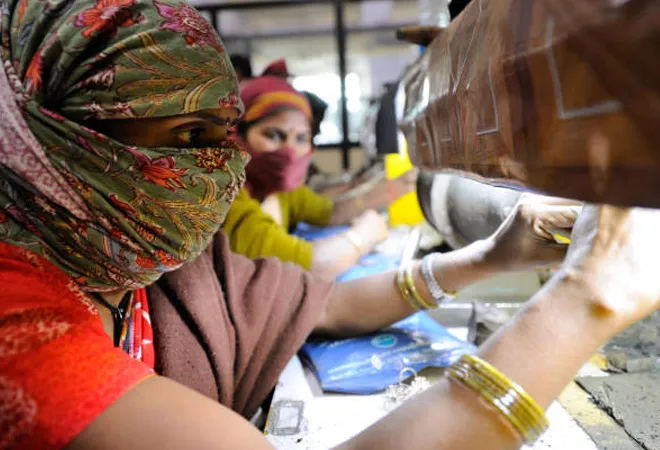
Introduction
The recently released State of Inequality Report presented by the Economic Advisory Council to the Prime Minister has sparked long-standing debates about introducing an ‘Urban Job Guarantee Scheme’ and assuring a Universal Basic Income Scheme. This dialogue is crucial, keeping in mind that t
he pandemic has ravaged and stifled urban labour markets in many developing economies. India’s urban centres have been at the frontline of the pandemic, battling with an ongoing livelihood crisis since 2020, when the lockdown and countrywide closures were first announced. Since the pandemic, cities have failed to maintain an inclusive and resilient ecosystem for the urban informal workforce that forms the backbone of urban infrastructure. In the year 2020,
eight out of 10 workers were out of a job in urban areas. The debate is pertinent as the ‘Right to Decent Work’ is an important Sustainable Development Goal (SDG) for 2030 and lies at the intersection of SDG 5 ‘Gender Equality’ due to its links with equal wage and equal opportunity to work.
Women’s overrepresentation in the unorganised sector had a significant role to play in the post-pandemic fall and the slow recovery of the Indian economy.
Over 90 percent of paid women workers are engaged in contact intensive informal jobs, such as domestic work, tourism and hospitality, gig work, sex work, construction work, and
in the beauty and wellness industry that was heavily affected during and post lockdown periods and haven’t yet completely picked up. T
he COVID-19 pandemic has intensified pre-existing inequalities within the informal workforce. We stand at an inflection point wherein if the urgency of the situation is not addressed, women would be the first ones to fall into chronic poverty traps and reverse years of gender gains, especially so in the context of India’s rapidly declining female labour force participation rate (FLFPR).
MGNREGA is often applauded for delivering equitable benefits like equal pay and more work opportunities to women in rural areas and having an overall positive impact on women’s socio-economic health. MGNREGA focuses on social equity concerns, with elements designed to modify and subvert existing power structures that foster prejudicial attitudes towards socially vulnerable groups, including women.
Given the bleak post-pandemic scenario and rampant unemployment, both the Union and State governments have recognised the pitfalls in the system. A survey undertaken by the Centre for Economic Performance together with the
London School of Economics shows that only 31 percent of individuals living in urban areas have a guaranteed number of days of work, whilst an overwhelming 70 percent of those without the guarantee, report needing at least 100 days to sustain. Discussions regarding rolling out an Urban Employment Guarantee Scheme building in the footsteps of Mahatma Gandhi National Rural Employment Guarantee Act (MGNREGA) have been underway. MGNREGA is often applauded for delivering equitable benefits like equal pay and more work opportunities to women in rural areas and having an overall positive impact on women’s socio-economic health. MGNREGA focuses on social equity concerns, with elements designed to modify and subvert existing power structures that foster prejudicial attitudes towards socially vulnerable groups, including women. It reinstates a legal framework for the right to work and wage parity between men and women. The Act reserves at least one-third of the total workdays for women, has a guaranteed minimum wage policy, has provisions for on-site childcare facilities (if more than six children are present), and stipulates that the work be provided in the local vicinity for women. State governments of Kerala, Himachal Pradesh, Jharkhand, Odisha, and most recently Rajasthan have spearheaded the movement of rolling out state-specific schemes for the urban unemployed and making them resilient to sudden economic shocks.
As the pandemic subsides and gives way to a recovering economy, scales could once again be tipped against women in the absence of gender-just policies or relief measures. Though well-intentioned, the schemes need to keep in mind t
he persistent gender-based occupational segregation of the informal workforce. A targeted Urban Employment Guarantee Scheme, one that addresses the
vulnerabilities faced by unemployed unskilled women dwelling in urban areas who often migrate with their families is the way to go forward.
Current perspectives and critique
Urban Employment Guarantee Scheme has been formulated and led by experts like Jean Drèze, an expert who formulated the Urban Employment Guarantee Scheme in India suggested a Decentralised Urban Employment and Training (DUET) scheme in September 2020 that guarantees demand-driven employment. In the proposal, he introduced
‘job stamps’, which could be given out to approved institutions and could be converted to one person-day of work. The work could be initiated in the purview of colleges, health centres, and urban local bodies, and also has proposed to link beneficiaries to adequate training centres. Another scheme structure proposed by
Azim Premji University guarantees 100 days of work and an initial rollout within small towns with a population of fewer than 10 Lakhs. The list of areas which could generate work includes the creation, rejuvenation, and monitoring of urban commons; public works such as the building and maintenance of roads, footpaths, and bridges.
The budget considerations also need to be kept in mind. On the other hand, municipal corporations have already specified budgets for maintaining the urban commons, which seems to overlap with that of this scheme.
Both of these proposals have emphasised structuring care-led recovery around women’s participation in the economy. They came to be critiqued based on their overdependence on urban local body infrastructure, which itself would be inadequate in managing a separate scheme. The budget considerations also need to be kept in mind. On the other hand, municipal corporations have already specified budgets for maintaining the urban commons, which seems to overlap with that of this scheme. The effects of minimum wage in urban areas on rural to urban migration would also be counterproductive.
In times of crisis, state governments have been principal innovators in terms of schemes that generate livelihoods for returning migrants. Domicile states such as Jharkhand or the states such as Himachal Pradesh that have responded to alarmingly high unemployment rates due to the pandemic are a few that we could look at.
A look at the ongoing schemes and state successes
In the view of enhancing livelihood security, Himachal Pradesh’s government in May 2020 announced ‘Mukhya Mantri Shahri Ajeevika Guarantee Yojana’ to provide 120 days of guaranteed unskilled wage employment to every urban household. It also focuses on facilitating skill enhancement and promoting better livelihood opportunities for those engaged in waged labour. The scheme boasts of
empowering the urban households by providing them with subsidies on credit linkages and entrepreneurship training to set up their enterprises. The scheme lists in its objectives, the aim to strengthen urban infrastructure and provision of quality civic amenities for the municipalities. The state had budgeted the scheme at INR 25.2 crores.
Similarly,
Odisha introduced its ‘Mukhyamantri Karma Tatpara Programme’ in April 2020. The initiative had an allocated budget of INR100 crore to generate temporary labour intensive jobs under the urban local bodies in areas of creation of public assets, monsoon preparedness, and maintenance of urban centres. Given the climate, Odisha faces heavy rainfall and cyclones that often damage property every year. It is a unique vision to formulate a scheme to solve glaring urbanisation and developmental challenges through potentially creating jobs in areas of water conservation by creating rainwater harvesting structures, preventing flooding, and rebuilding urban areas. Odisha has been a pioneer among the recent Urban Employment Guarantee Schemes by engaging rural and urban self-help groups of marginalised women in this endeavour.
It is a unique vision to formulate a scheme to solve glaring urbanisation and developmental challenges through potentially creating jobs in areas of water conservation by creating rainwater harvesting structures, preventing flooding, and rebuilding urban areas.
Jharkhand has launched a similar scheme ‘Jharkhand Mukhyamantri Shramik Yojana’. It has been created with a vision to provide work to 5 lakhs unskilled urban dwellers for 100 days (person days). This scheme was launched as a direct measure to counter the inflow of people (5.3 Lakh till September 2020) heading back to their domicile state as a result of the reverse migration, post announcement of the lockdown.
Kerala’s experience is a bit different in the sense that its ‘Ayyankali Urban Employment Guarantee Scheme’ (AUEGS) has been functional and successful since 2011. This scheme envisages providing 100 days of guaranteed unskilled work to every household. The AUEGS has been exemplary in creating a comprehensive roadmap for the other states to follow during the COVID-19 crisis. The areas included under which work is provided in the scheme, focus on public service and improving the urban infrastructure and ecosystem. Under
AUEGS, 94,783 women have benefitted in 2019-2020 alone. AUEGS has been successful in providing opportunities to further the Female Labour Force Participation Rate (FLFPR) in urban areas.
Roadmap to a gender-responsive policy
The State of Inequality Report has once again triggered the discussion on providing a livelihood scheme to pull the urban unemployed from the depths of poverty. Mentioned below are some recommendations that would help in formulating a care led recovery trajectory for India.
- Safety issues are regarded as one of the biggest hurdles to women’s entry into the workforce. Unsafe working space affects the quality of work and hampers women’s quality of life and mental health as well. Urban Employment Schemes need to have a focus on safety issues and include provisions like a budget for CCTV cameras, and functional emergency helplines, and emphasise regular police patrolling.
- Reservation of jobs for women much like MNREGA would help more women to step in and take on jobs under Urban Employment Guarantee schemes. Affirmative action-based policies go a long way in increasing representation from traditionally marginalised communities, thereby, delivering benefits to the last mile.
- Equal wages for both men and women have had a positive impact on women working under MNREGA in rural areas who tend to be underpaid in comparison to men. Including the creation of more jobs suitable for women.
- Addressing the gender digital divide would also open up women to digital opportunities of work which tend to be overlooked. Providing skills in digital empowerment would have a positive domino effect on other marginalised sections of the society as well.
- Time flexibility is essential for women to be able to handle their unpaid care work responsibilities. Consideration of these hurdles would attract more women to join the workforce and be able to earn a living.
The socio-economic toll of the pandemic on women and girls has the potential to plunge the population into long-term poverty traps. The targeted and gender-sensitive policy response is the way to avoid reversing years of gains in gender parity and GDP.
The views expressed above belong to the author(s). ORF research and analyses now available on Telegram! Click here to access our curated content — blogs, longforms and interviews.




 PREV
PREV


